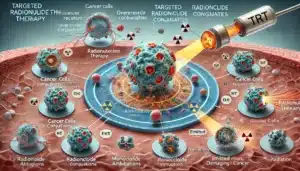This article analyses key Phase III clinical trials for three significant therapies: ALSYMPCA, NETTER-1, and VISION. These trials are essential in advancing treatment options for patients with advanced prostate cancer, neuroendocrine tumours, and metastatic castration-resistant prostate cancer, respectively. The analysis includes each trial’s objectives, methodologies, and results, offering an understanding of their contributions to medical science.
Introduction to Phase III Clinical Trials
Phase III clinical trials are a critical step in the development of new medical treatments and therapies. These trials are conducted after initial safety and efficacy are established in Phase I and Phase II trials. The primary goal of Phase III trials is to confirm the effectiveness of a treatment in a larger population, monitor side effects, compare it to commonly used treatments, and collect information that will allow the treatment to be used safely.
In Phase III trials, researchers enrol a large number of participants, often ranging from several hundred to several thousand. These Phase III trials involve rigorous testing protocols and usually span multiple locations and countries to ensure diverse patient demographics and robust data. The trials are typically randomised and controlled, with participants assigned to either the new treatment group or a control group receiving a standard treatment or placebo. This helps in providing a clear comparison and understanding of the new treatment’s performance.
The outcomes of Phase III trials are pivotal in the regulatory approval decision-making process. Successful results can lead to the submission of a New Drug Application (NDA) or Biologics License Application (BLA) to regulatory bodies such as the U.S. Food and Drug Administration (FDA) or the European Medicines Agency (EMA). These regulatory submissions are necessary for the new treatment to be marketed and made available to the general public.
This article will review the details of three significant Phase III trials: ALSYMPCA, NETTER-1, and VISION. Each of these trials has contributed substantially to the advancement of treatments for various forms of cancer, offering new hope and improved outcomes for patients. The following sections will explore the objectives, methodologies, and results of these trials, highlighting their importance in the field of oncology.
ALSYMPCA Phase III Clinical Trial
Objective
The ALSYMPCA (ALpharadin in SYMptomatic Prostate CAncer) trial aimed to evaluate the efficacy and safety of Radium-223 dichloride (Ra-223) in patients with castration-resistant prostate cancer (CRPC) with bone metastases.
Methodology
This international, randomised, double-blind, placebo-controlled Phase III trial involved 921 patients. Participants were randomly assigned in a 2:1 ratio to receive either Ra-223 or a placebo, along with the best standard of care. The primary endpoint was overall survival, with secondary endpoints including time to first symptomatic skeletal event, alkaline phosphatase (ALP) normalisation, and safety.
Results
The ALSYMPCA trial significantly improved overall survival for patients treated with Ra-223 compared to those receiving the placebo. The median overall survival was 14.9 months for the Ra-223 group versus 11.3 months for the placebo group. Additionally, Ra-223 significantly delayed the time to the first symptomatic skeletal event and led to notable reductions in ALP levels, indicating a reduction in bone turnover. The safety profile of Ra-223 was favourable, with fewer haematological side effects compared to other treatments.
NETTER-1 Phase III Clinical Trial
Objective
The NETTER-1 trial was designed to assess the efficacy and safety of Lutetium-177-DOTATATE (Lu-177-DOTATATE) in patients with advanced midgut neuroendocrine tumours (NETs) that express somatostatin receptors and have progressed under standard therapy.
Methodology
In this randomised, open-label, multicentre Phase III trial, 229 patients were assigned to receive either Lu-177-DOTATATE combined with best supportive care or high-dose octreotide LAR (long-acting repeatable). The primary endpoint was progression-free survival (PFS), with secondary endpoints including overall survival, objective response rate, quality of life, and safety.
Results
The NETTER-1 trial demonstrated that Lu-177-DOTATATE significantly improved PFS compared to high-dose octreotide LAR. The median PFS was not reached in the Lu-177-DOTATATE group at the time of the primary analysis, whereas it was 8.4 months in the control group. The trial also showed a higher objective response rate and improved quality of life in the Lu-177-DOTATATE group. The treatment was generally well-tolerated, with manageable side effects primarily involving nausea, vomiting, and transient haematological toxicities.
VISION Phase III Clinical Trial
Objective
The VISION trial aimed to evaluate the efficacy and safety of Lutetium-177-PSMA-617 (Lu-177-PSMA-617) in patients with metastatic castration-resistant prostate cancer (mCRPC) who had progressed after standard therapies.
Methodology
This Phase III, randomised, open-label trial enrolled 831 patients, randomly assigned in a 2:1 ratio to receive either Lu-177-PSMA-617 plus the best standard of care or the best standard alone. The primary endpoints were overall survival and radiographic progression-free survival (rPFS), with secondary endpoints including objective response rate, disease control rate, and safety.
Results
The VISION trial reported a significant improvement in both overall survival and rPFS for patients treated with Lu-177-PSMA-617 compared to those receiving standard care alone. The median overall survival was 15.3 months in the Lu-177-PSMA-617 group versus 11.3 months in the control group. The median rPFS was 8.7 months for the treatment group compared to 3.4 months for the control group. Additionally, the Lu-177-PSMA-617 group showed a higher objective response rate and disease control rate. The safety profile was manageable, with the most common side effects being fatigue, dry mouth, and haematological toxicities.
Discussion
These three Phase III trials—ALSYMPCA, NETTER-1, and VISION—highlight significant advancements in the treatment of advanced prostate cancer, neuroendocrine tumours, and mCRPC. Each trial demonstrated the potential of targeted radiopharmaceutical therapies to improve survival outcomes and quality of life for patients with these challenging conditions.
ALSYMPCA Implications
The results from the ALSYMPCA trial established Ra-223 as a viable treatment option for patients with CRPC and bone metastases, providing a new approach that extends survival and improves patients’ quality of life by reducing skeletal-related events and bone pain. This trial underscored the importance of targeting bone metastases in prostate cancer treatment, paving the way for further research into radiopharmaceuticals.
NETTER-1 Implications
The success of the NETTER-1 trial in extending PFS and improving the quality of life for patients with midgut NETs positioned Lu-177-DOTATATE as a valuable therapy in this context. The findings support the use of peptide receptor radionuclide therapy (PRRT) as a standard treatment for somatostatin receptor-positive NETs. This trial also highlighted the need for ongoing long-term safety and efficacy monitoring, given the chronic nature of NETs.
VISION Implications
The VISION trial confirmed the efficacy of Lu-177-PSMA-617 in improving survival outcomes for patients with mCRPC, a population with limited treatment options. The trial’s results advocate for the integration of PSMA-targeted radioligand therapy into the standard treatment regimen for mCRPC. Future research will be essential to optimise treatment protocols, manage side effects, and explore combination therapies to enhance patient outcomes further.
The table below compares the differences in the Phase III clinical trials: ALSYMPCA, NETTER-1, and VISION:
| Trial | Condition | Therapy | Primary Endpoint | Participants | Results | Side Effects |
| ALSYMPCA | Castration-resistant prostate cancer with bone metastases | Radium-223 dichloride (Ra-223) | Overall survival | 921 | Median overall survival: 14.9 months (Ra-223) vs. 11.3 months (placebo); Reduced skeletal events | Fewer haematological side effects |
| NETTER-1 | Advanced midgut neuroendocrine tumours | Lutetium-177-DOTATATE (Lu-177-DOTATATE) | Progression-free survival | 229 | Median PFS not reached (Lu-177-DOTATATE) vs. 8.4 months (control); Improved quality of life | Nausea, vomiting, transient haematological toxicities |
| VISION | Metastatic castration-resistant prostate cancer | Lutetium-177-PSMA-617 (Lu-177-PSMA-617) | Overall survival and radiographic progression-free survival | 831 | Median overall survival: 15.3 months (Lu-177-PSMA-617) vs. 11.3 months (control); Better disease control | Fatigue, dry mouth, haematological toxicities |
Conclusion
The ALSYMPCA, NETTER-1, and VISION Phase III trials represent significant milestones in cancer treatment. They showcase the potential of radiopharmaceuticals to improve survival and quality of life for patients with advanced cancers. The positive outcomes of these trials provide a strong foundation for the continued development and refinement of targeted therapies, offering hope for better management of these challenging conditions. As research progresses, these therapies may become integral components of standard cancer care, transforming treatment paradigms and improving patient prognoses.
Q&A on ALSYMPCA, NETTER-1, and VISION Phase III Clinical Trials
Q1: What was the primary objective of the ALSYMPCA trial?
A1: The primary objective of the ALSYMPCA trial was to evaluate the efficacy and safety of Radium-223 dichloride (Ra-223) in patients with castration-resistant prostate cancer (CRPC) with bone metastases, focusing on overall survival.
Q2: How many participants were enrolled in the NETTER-1 trial, and what was the condition being treated?
A2: The NETTER-1 trial enrolled 229 participants and aimed to treat advanced midgut neuroendocrine tumours (NETs) that express somatostatin receptors.
Q3: What were the primary and secondary endpoints of the VISION trial?
A3: The primary endpoints of the VISION trial were overall survival and radiographic progression-free survival (rPFS). Secondary endpoints included objective response rate, disease control rate, and safety.
Q4: What significant results were reported from the ALSYMPCA trial?
A4: The ALSYMPCA trial reported that patients treated with Ra-223 had a median overall survival of 14.9 months compared to 11.3 months for the placebo group. Additionally, Ra-223 significantly delayed the time to the first symptomatic skeletal event and led to notable reductions in ALP levels, indicating reduced bone turnover.
Q5: How did Lu-177-DOTATATE perform in the NETTER-1 trial regarding progression-free survival?
A5: In the NETTER-1 trial, Lu-177-DOTATATE significantly improved progression-free survival (PFS) compared to high-dose octreotide LAR. The median PFS was not reached in the Lu-177-DOTATATE group at the time of the primary analysis, whereas it was 8.4 months in the control group.
Q6: What were the common side effects observed in the VISION trial for patients treated with Lu-177-PSMA-617?
A6: The common side effects observed in the VISION trial for patients treated with Lu-177-PSMA-617 included fatigue, dry mouth, and haematological toxicities.
Q7: What impact did the NETTER-1 trial have on the quality of life for patients?
A7: The NETTER-1 trial showed that patients treated with Lu-177-DOTATATE had an improved quality of life compared to those receiving high-dose octreotide LAR, with better symptom management and reduced tumour size.
Q8: Describe the mechanism of action of Ra-223 as used in the ALSYMPCA trial.
A8: Radium-223 dichloride (Ra-223) targets bone metastases by mimicking calcium and selectively binding to areas of increased bone turnover, such as those affected by metastases. It emits alpha particles that cause double-stranded DNA breaks in adjacent cancer cells, leading to tumour cell death while sparing surrounding healthy tissue.
Q9: What was the condition of the patient population in the VISION trial, and why was Lu-177-PSMA-617 chosen as a treatment?
A9: The patient population in the VISION trial consisted of individuals with metastatic castration-resistant prostate cancer (mCRPC) who had progressed after standard therapies. Lu-177-PSMA-617 was chosen because it targets PSMA (Prostate-Specific Membrane Antigen), which is highly expressed in prostate cancer cells, allowing for targeted radioligand therapy.
Q10: What are the implications of the positive outcomes from these three trials for future cancer treatments?
A10: The positive outcomes from the ALSYMPCA, NETTER-1, and VISION trials highlight the potential of targeted radiopharmaceutical therapies to improve survival and quality of life for patients with advanced cancers. These results pave the way for integrating these therapies into standard treatment regimens and encourage further research into optimising treatment protocols, managing side effects, and exploring combination therapies for even better patient outcomes.
You are here: home » medical imaging blog »

